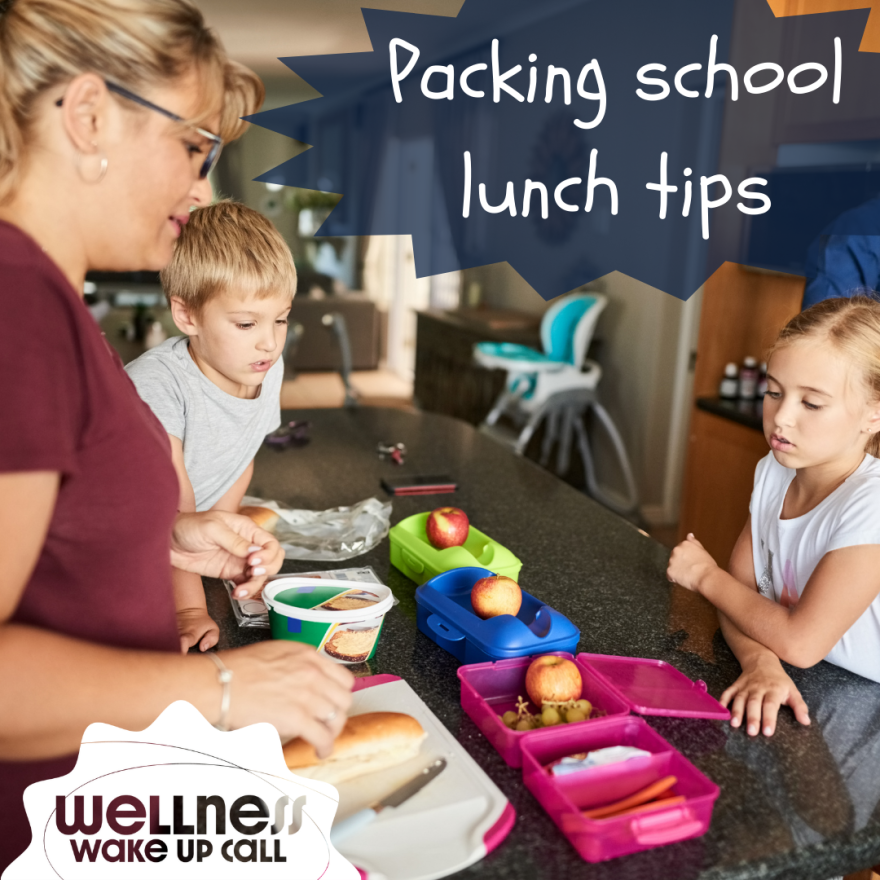Good morning, this is your Wellness Wake Up Call with Kristin Bogdonas, nutrition and wellness educator with University of Illinois Extension.
Welcome to August. For many, it’s back to school month. This week, we are talking about packing healthy school lunches and snacks. According to the National School Lunch Program, about 60% of students eat school lunch. The other 40% bring lunch to school. Lunch is an important part of the day. Studies have shown that if students are well-fed, they perform better academically. It’s an essential part of the day so here are some tips to keep your packed lunches and snacks safe and full of the brain-boosting nutrients they need to succeed.
When packing school lunches, it’s important to keep food safety in mind. To keep food safe between home and lunchtime, there are several steps to take to keep food out of the temperature danger zone, especially if packing potentially hazardous foods. The Danger Zone is between 41 and 135°F. Use an insulated lunch box with at least two ice sources such as frozen gel packs or frozen bottles of water. Put a cold source on the bottom and top so food stays cold in between. This is an important step for perishable foods like lunch meats, poultry, fish, eggs, dairy, cooked leftovers, and sliced produce. Non-perishable foods include whole fruits and vegetables, hard cheese, canned meat and fish, chips, breads, crackers, peanut butter, jelly, mustard, and pickles. These foods do not require cold packs, or refrigeration.
MyPlate messaging recommends incorporating whole goods from all of the food groups. A healthful lunch should include:
• Fruits such as apples, bananas, grapes, oranges, and pears, or dried fruit like raisins, apricots, or banana chips
• Colorful, bite-sized pieces from the vegetable group, such as cherry tomatoes, cucumber slices, jicama sticks, leafy greens, peppers, or sugar snap peas.
• Whole grains like brown rice, pasta, whole wheat bread, crackers or popcorn.
• Dairy foods including milk, cheese or yogurt.
• Lean proteins like chicken, turkey, eggs, beans, tofu, or lentils.
Try to get your child involved in packing their own lunch and have them pick items from each food group to include. To add to the visual appeal, use mini containers to keep foods separated, like silicone cupcake cups, reusable portion bags, and colorful picks to make food look fun and appetizing. Children can even make ahead some foods the night before. Easy ideas for kids would be fruit kabobs, homemade popcorn, or trail mix and a colorful rainbow wrap with homemade dressing.
Do some lunch planning with your child or grandchild to get them excited about eating lunch. Give a special treat once in a while and remember to switch it up. MyPlate messaging also recommends to add variety. Each week, have your child pick out a new fruit or vegetable to try from the grocery store. Have you ever had raspberry oranges or dragon fruit? What about jicama or purple radishes? It seems like there is always something new and exciting to try so keep your eyes peeled!
Finally, remember not to overpack and be aware of appropriate serving sizes. Pack the amount of food that can be eaten at lunchtime. For example, 15 crackers may be the serving size listed on a label; however, the number of crackers you serve your child will vary based on different calorie needs. Recommended portion sizes for children 7-10 would include:
• 4-5 crackers and ½ cup rice
• ½ cup cooked or 1 piece of fruit
• ½ cup cooked beans or 2-3 oz of chicken
• 1 cup milk or yogurt
This week, make a list of the foods that your child or grandchildren prefer from each of the food groups. Let them help you create a meal and snack plan for the week to ensure they’re getting all the nutrients they need.
For additional resources and a recording of today’s episode, please visit wvik.org/wellness or you can subscribe to Wellness Wake Up Call today wherever you listen to podcasts and never miss out on these weekly wellness tips.
Thank you for listening! I hope you have a happy and healthy day ahead. The content for this episode was provided by Susan Glassman, nutrition and wellness educator with University of Illinois Extension.
Related resources:
• Keeping Bag Lunches Safe; https://usafacts.org/articles/how-many-us-children-receive-a-free-or-reduced-price-school-lunch/https://www.ncbi.nlm.nih.gov/pmc/articles/PMC2908954
• Build a Better Bagged School Lunch; https://njaes.rutgers.edu/fs1242/How Much Water Do You Need Each Day?; Rhaza Amad, MD., May 20, 2015.
• How to Make School Lunches Your Children Will Not Trade or Throw Out; https://extension.unh.edu/blog/2017/08/how-make-school-lunches-your-children-will-not-trade-or-throw-out



